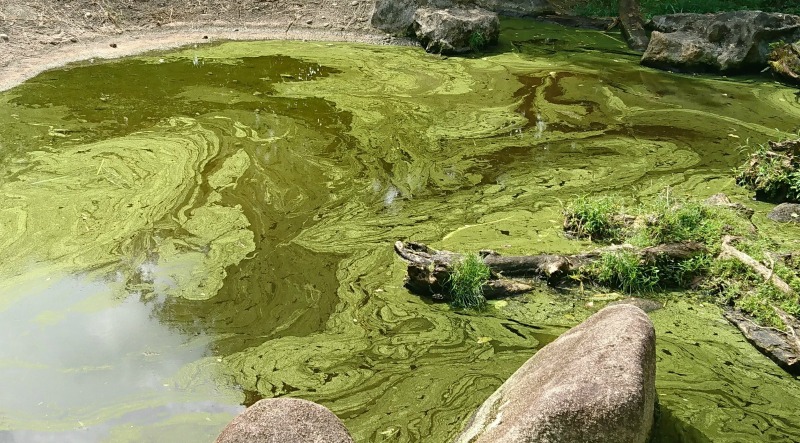Cyanobacteria (or more commonly called ‘blue-green algae’) can have a poisonous reaction in dogs, cats and other animals. This microscopic bacteria is found in freshwater lakes, ponds, and other similar bodies of water. When a group of algae grows and comes together, it forms ‘blooms’ that give the water a murky blue-green colour almost like paint on the water in appearance. Because the algae float, they can easily move towards the shore with a strong wind or movement in the water which provides easy access to animals. They can separate from each other and not show that murky colouring, meaning the water can be toxic even if the algae cannot be seen on the surface.
The amount of algae in the water at any given time varies throughout the year, but it is most abundant during periods of hot weather in mid-to-late summer months and is commonly found in nutrient-rich water. Many blue-green algae blooms do not produce toxins, but it is impossible to know which ones do or don’t without testing, so all blooms should be considered potentially toxic. Even just a few small mouthfuls of algae-contaminated water may result in fatal poisoning.
It is tough during the warm months to keep our dogs who love swimming and playing in the lakes and ponds away from the water, but it is in the best interest for their health and well-being to use caution. If you believe your pet has been exposed to blue-green algae, you should contact your veterinarian immediately. The clinical signs we may see depend on the toxin involved, as blue-green algae can produce anatoxins or microcystins. If its microcystins the particular bloom produces, this can result in liver damage or failure. Liver damage signs can include vomiting, diarrhea, blood in stool, weakness, jaundice, seizures, disorientation, coma and more. Liver failure is often the reason death generally follows within days. Getting in touch with your veterinary hospital right away is crucial – aggressive. Immediate treatment is necessary to treat this fast-acting poison.
If anatoxins are the toxin produced by the particular bloom that the pet is exposed to, these toxins result in neurotoxicity typically shown through excessive drooling or eye weeping, neurologic signs (including muscle tremors, muscle rigidity, or paralysis), blue discoloration of the skin and gums, and difficulty breathing. Due to the respiratory paralysis that follows, death usually happens within minutes to hours of exposure. Treatment of this exposure includes anti-seizure medication, oxygen therapy and aggressive medical care by your veterinarian.
There is no antidote for the toxins produced by blue-green algae—that’s why immediate veterinary care is crucial. If you suspect your pet has been exposed to blue-green algae, contact your veterinarian or the Pet Poison Helpline immediately for guidance.
Written by: Tracey Westhaver, Reception Manager




